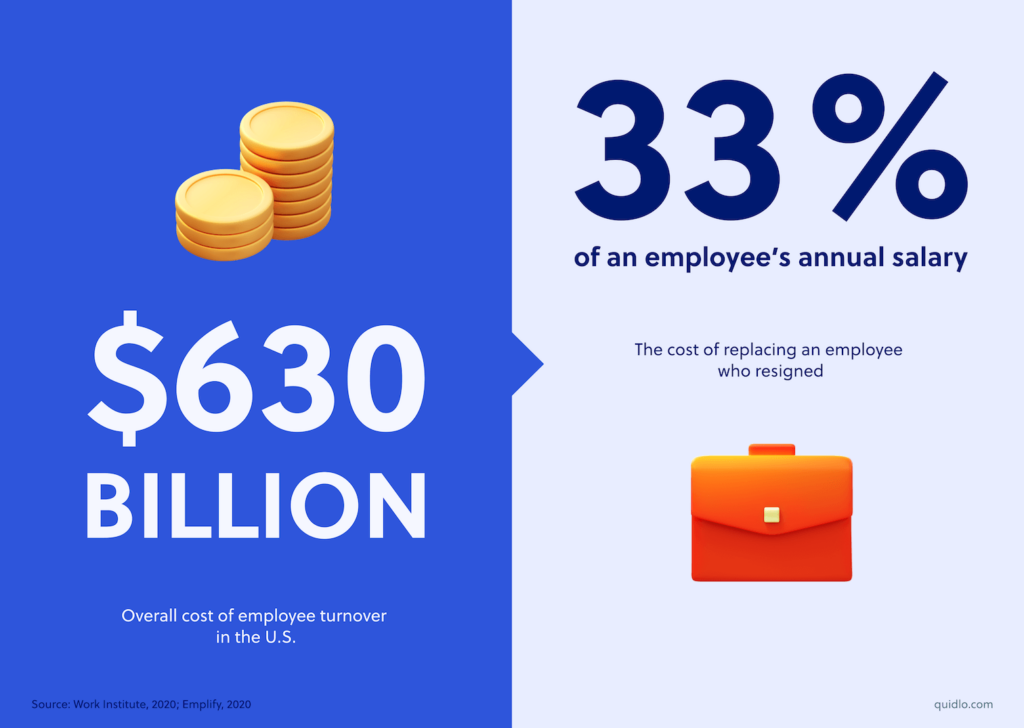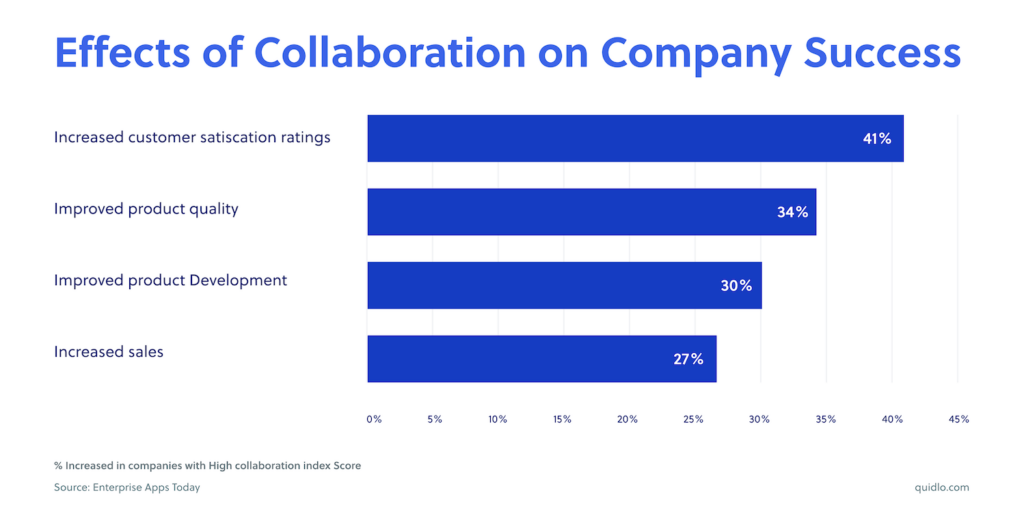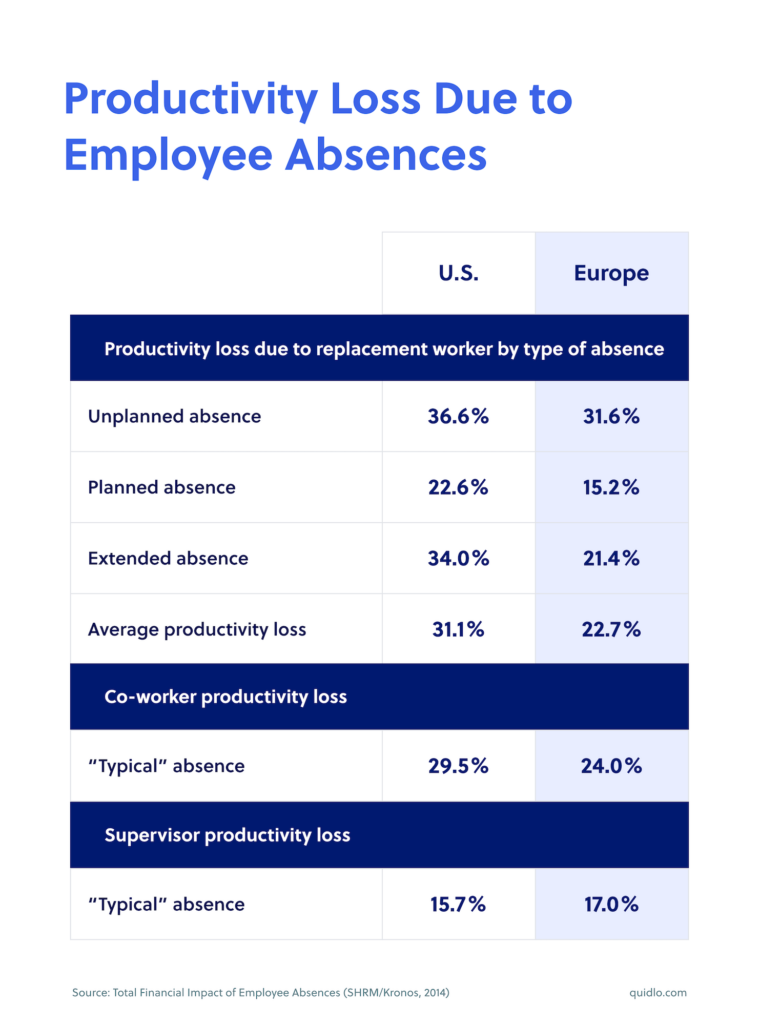Tracking employee performance is always tricky. How can it be done fairly? What metrics should I use to get the full picture?
These are some of the questions we’ll answer in this article. So, read on to learn about the five most important employee performance metrics you must track. But let’s start at the top.
Table of Contents
What Are Employee Performance Metrics?
Employee performance metrics are analytics used to track how employees perform in the workplace. Measuring employee performance using these metrics gives you insights into how efficiently your organization is operating.
These insights can tell you which employees are contributing to key goals and show you areas of improvement. Generally speaking, employee performance metrics measure three things:
Work quality
What is the quality of work being produced by employees? Some jobs and tasks are easy to measure as you can use quantifiable data.
For example, the number of products sold or leads generated. Other jobs are more qualitative, like customer service, but there are still ways to gauge the work quality of these types of roles.
Efficiency and speed
How much is accomplished over a given time frame, and are deadlines and employee performance goals met? Is the employee managing their time and resources in the best possible way?
Trust and consistency
Is the work quality, speed, and efficiency consistent, or does an employee produce varied results? Can the employee be trusted to produce the same results without supervision?
To give you more insight into employee performance metrics, it’s worth looking at the history of the practice. Performance metrics can be traced back to the 1920s when businesses used performance management to increase production. As you can imagine, there was more of a focus on customer satisfaction than employee satisfaction and personal growth at this time.
By the 1950s, measuring employee performance using metrics we might be familiar with today was introduced. Employees started to be rated on traits such as loyalty, job knowledge, and trustworthiness. But these categories did little to assess employee productivity.
A decade later, more formal annual employee performance evaluation became commonplace. The focus shifted onto what the employee may be able to achieve in the future, with the introduction of performance-based objectives and goals.
In the 1970s and through to the 1990s, companies sought more objective performance metrics, and rating scales were introduced. Most notably, the multi-rating 360-degree feedback system was popularized.
Only in the early 2000s did the focus on employee performance metrics shift to engagement and motivation. Also, companies started to use more continuous feedback practices instead of one annual review.
From understanding the history of employee performance metrics, we can learn what works and what doesn’t. But it also shows us that employee performance metrics are an evolving discipline and can always be improved.
Another vital question to consider is: what kind of businesses benefit from tracking employee performance metrics? The short answer is most businesses benefit from tracking employee performance metrics. If the business has employees and objectives it needs to meet, it can benefit from tracking employee performance metrics.
However, bigger corporate businesses with lots of employees working on many different objectives benefit the most from tracking performance metrics. That’s because it’s harder to gauge the performance of a complex operation or give individual feedback regularly without a framework.
The only businesses that may see little benefits from employee performance metrics are small businesses where the manager is heavily involved. Within such an environment, the cost may outweigh the benefits as the manager can provide informal feedback regularly and make changes on the spot if an issue arises.
Benefits of Tracking Employee Performance Metrics
Tracking employee performance metrics not only helps you evaluate your employees but your whole business. Tracking the right metrics (more on that later) will help you achieve targets and goals and get the most out of your employers.
You can also use the findings to improve employee morale, increase retention, and reduce turnover. When the performance metrics aren’t met, you can use the information to make strategic decisions to improve the situation; performance improvement plans are useful for this.
Now let’s break down the main benefits of tracking employee performance metrics: better performance, setting expectations, and employee satisfaction.
Better performance
Tracking employee performance helps eliminate complacency in both leadership roles and junior employees. Managers are more likely to address underperforming employees if the issue is made aware through a performance review.
Employee performance reviews allow both the manager and employee to work on solving the issue together, as both are on the same page. As a result, misconceptions are avoided, and the right training or other resources can be provided to ensure all employees hit their goals.
On the other hand, if an employee is doing a good job, this will be recognized. When the employee’s good work is recognized, they are more likely to continue or even improve their performance since they feel valued.
Performance reviews also allow HR to hire employees that are likely to meet the performance metrics. Knowing what skills and attributes will give a good performance makes it easier to hire the right person.
Expectations
Performance reviews allow employees to know what is expected of them. When employees know what is expected of them, they can work towards these clearly defined goals. Some employees will even push themselves to surmount expectations.
Most employees want to perform their jobs well, so some underachieving employees fail because they don’t know what is expected of them or don’t have the right tools for the job.
Performance reviews allow a dialogue between leadership and junior employees; the leadership lays out expectations and the metrics they’ll use to determine if the expectations are met. Meanwhile, regular employees communicate what can be done for them to succeed.
Employee satisfaction
An employee resigning typically costs a company up to a third of the employee’s annual salary in both lost productivity and hiring costs.

Resignations also strain the remaining employees who have to pick up the slack of the resignee, decreasing their job satisfaction. It can have a terrible knock-on effect on the whole department.
So keeping your employees satisfied is important.
Luckily, utilizing performance metrics helps increase employee satisfaction. Studies show that 43% of highly engaged employees receive regular feedback.
The reason employees feel more satisfied is, firstly, employees who consistently give a top performance feel more valued if they are told they’re doing a good job. For struggling employees, a performance review gives them the tools to improve and allows a dialogue.
A performance review is more structured and feels fairer than inconsistent feedback. Employees feel less demoralized if they know how to improve and if they feel the criticism is objective and considered.
Reduces turnover
Performance metrics can help reduce staff turnover. When workers know what’s expected of them and the companies open a dialogue to discuss how these expectations can be met, they’ll be less likely to quit.
Yet, without performance metrics, you’ll have no way to gauge how your employees are doing. Moreover, the lack of metrics may convey the feeling that performance and review ratings are arbitrary.
That leads to reduced employee morale and an increased likelihood of turnover. That’s why it’s crucial to establish and communicate clear performance metrics.
Most Important Employee Performance Metrics to Track
Without wasting any more time, here are the five critical employee performance metrics you need to track:
Efficiency
The first employee metric you should track is work efficiency. Efficiency can be defined as a combination of resource utilization and time management skills; it’s the output of an employee and their contribution to the business.
Here’s a simple way to measure how efficient an employee is:
Work out the average number of tasks completed by your employees during a given time frame.
Assess the number of tasks completed by an individual employee during the given time frame
You need to account for part-time employees and overtime work to get an accurate result, but this method will tell you who produces the most output.
If your employees are making sales calls or producing units, assessing the quantity of work produced is even easier. Simply look at how many sales made or units produced and account for factors like luck and how difficult a particular product is to produce compared to other products.
But the raw quantity of work is not the only indicator of employee efficiency; you also need to account for the quality of work of each team member.
Assessing a team member’s work quality is not as simple as quantity. The best way to assess the quality of work is to ask management to compile a list of the most impactful projects that have propelled the business forward. The employees that contributed to these projects are producing high-quality work.
Tracking efficiency is essential as it highlights areas an employee needs to improve. For example, the employee may be producing a large quantity of work, but the quality of the work may be lacking. If this is the case, the employee can integrate producing higher quality work into their performance plan.
Teamwork
Teamwork is an important metric as it allows complex problems to be solved by utilizing the collective abilities of a group of employees. With good team dynamics, ideas can flow, responsibility is shared, stress levels are reduced, and errors are more likely to be spotted.

You can gauge an employee’s teamwork skills by assessing these metrics:
How often an employee reaches out to other employees for assistance with their tasks?
Good teamwork means an employee will reach out for help, but only when necessary. Obviously, if an employee asks for help on every task, it may indicate an issue.
Willingness to share ideas with coworkers.
An employee willing to share ideas and brainstorm with colleagues is a good indicator of a team player.
Mentoring other employees
If an employee has a record of mentoring and assisting other employees, they are most likely a team player.
Volunteering for complex tasks and projects
Team players don’t just help when the task is straightforward. A good team player will volunteer for complex projects that require a wide pool of knowledge.
Results of pulse surveys
For a more objective analysis of teamwork, you can send your employees a pulse survey that asks who they would like to collaborate with on team projects in the future. If other employees want to work with a particular employee, it’s a good indication they are team players.
By assessing these metrics, you will have a good idea of the teamwork skills of your employees.
Ability and willingness to learn
There are many benefits for individual employees who are willing to learn and have the ability to do so. It’s easier for employees with these abilities to adapt to new trends and try new approaches. That’s why they’re usually a valuable asset to modern businesses that deal with constantly changing market dynamics.
For a business, having employees who are willing and able to learn gives you an extra edge over your competition. It provides your company the flexibility it needs to evolve efficiently with the changing market trends.
An excellent way to determine if your employees have a strong learning ability is to encourage them to take online training programs. By participating in an online training program, you can assess the following metrics:
Program completion
If your employee completes the course, this is a good indicator of learning ability and willingness. Also, by making the training course optional, you can better assess the employee’s willingness to learn.
Course engagement
Some employees will complete the course with a bare minimum of effort. But if employees complete the course and give insightful, well-thought-out contributions, they are likely effective, willing learners.
Certification level
If employees have gained certifications and additional training for their role, they are most likely willing and skilled learners.
Examination scores
An employee’s performance in external exams and exams taken during their employment term can indicate their ability and willingness to learn.
You can also ask employees to take examinations specifically for the performance review, but depending on the industry, this may be asking too much.
Initiative
Initiative is when an employee goes above and beyond or does what needs to be done without being asked. An employee who shows initiative is engaged with the business. You want such employees in your team.
Initiative is important as it allows a business to adapt to changing conditions. A problem is much easier to solve if employees are willing to tackle it without being asked. Having a workforce with initiative frees up management to think about the bigger picture rather than micromanage unmotivated employees.
But initiative is another performance metric that is difficult to track. The best way to track initiative is to have a management record when an employee takes the initiative.
Another effective way is to solicit feedback from employees and management to see who has this quality. But remember, taking the initiative doesn’t have to be a grand gesture; working unsupervised is an example of taking the initiative that is quite easy to gauge for an attentive manager.
Overtime absenteeism and rate
Although one of the more unconventional employee performance metrics, the amount of overtime an employee does and how often they are absent is a performance metric that is easier to track. You have numerical values to work with, giving you precise, unbiased results.
To track an employee’s absenteeism rate, simply divide the number of days they were absent by the number of days they were scheduled to work and multiply by 100. You will get a percentage rate to compare your employees’ absentee rates.
Calculating your employees’ overtime percentage can be done in the same way by dividing the overtime hours by the regular hours and multiplying by 100.
But what does the absenteeism and overtime rate tell you about your employees? Frequent absenteeism affects productivity and puts a burden on your other employees. If other employees have to pick up the slack of a frequent absentee, their productivity and morale will also be affected.
As you can see below, employee absence can lead to severe productivity losses.

But overtime is more complicated. High overtime rates may be an indicator of many things, like understaffing and low productivity, rather than a high-performing employee.
A medium level of overtime means an employee is committed and willing to work when needed, which is a sign of a high performer. An employee that isn’t willing to do any overtime is likely uncommitted and unengaged rather than highly productive.
But like all these metrics, they need to be viewed in conjunction with other key performance indicators to get a full picture of an employee’s performance.
In Closing
Employee performance metrics help you measure employee performance in a fair, systematic way. Tracking these metrics during employee performance appraisal shows you where to make changes to increase the performance of your employees; it’s beneficial for both the individual and the business.
By implementing key performance metrics, your employees will perform better, be more satisfied in their roles, less likely to leave, and be aware of the company’s expectations. Everyone is on the same page, which leads to business success.
But remember to do employee performance evaluations regularly and be prepared to adapt the metrics to the changing business environment. Listen to what your employees have to say regarding the metrics as well; performance reviews should be a conversation that benefits both regular employees and management.







